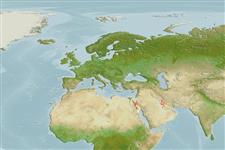Classification / Names
Noms communs | Synonymes | Catalog of Fishes(Genre, Espèce) | ITIS | CoL | WoRMS | Cloffa
>
Eupercaria/misc (Various families in series Eupercaria) >
Labridae (Wrasses) > Cheilininae
Etymology: Pteragogus: Greek, pteron = wing, fin + Greek, ago = to drive (Ref. 45335); trispilus: Named trispilus from the Latin for the three black spots anteriorly on the dorsal fin, one on each of the first three membranes (Ref. 93522).
Environment: milieu / climate zone / depth range / distribution range
Écologie
marin récifal; profondeur 9 - 35 m (Ref. 93522). Subtropical
Red Sea: Gulf of Aqaba and Gulf of Suez. Mediterranean Sea: Lessepsian migrant to the eastern Mediterranean Sea, primarily as Pteragogus pelycus.
Taille / Poids / Âge
Maturity: Lm ? range ? - ? cm
Max length : 7.9 cm SL mâle / non sexé; (Ref. 93522)
Description synthétique
Morphologie | Morphométrie
Épines dorsales (Total): 11; Rayons mous dorsaux (Total): 9; Épines anales 3; Rayons mous anaux: 9; Vertèbres: 25. This species is distinguished by the following characters: D XI,9; A III,9; pectoral rays 13 (rarely 12); complete lateral line, angling sharply downward below soft part of anal fin to straight peduncular part; pored scales 24 (plus 2 on base of caudal fin, the last greatly enlarged); body moderately deep, depth 2.75-2.95 in SL; head length 2.7 in SL; dorsal profile of head straight in adult female, with adult male, a very a slight concavity above eye; interorbital convex; orbit diameter 4.15-5.4 in head length; straight part of posterior margin of preopercle serrate, the serrae varying from 14 on 27-mm paratype to 23 on 73-mm holotype; no long filaments extending from tips of dorsal spines; caudal fin rounded and moderately long, 2.7-3.1 in SL; very long first soft ray of pelvic fins, 2.0-3.3 in SL. Color when fresh olivaceous, scale edges dotted with white, an oblique elliptical black spot on opercle, broadly rimmed in yellow, a vertical white streak to each side of posterior edge of preopercle, scattered small black spots behind eye and on nape, pupil rimmed with orange, the rest of iris with 7 spoke-like dark lines, lateral line with black dots and dashes and white dots, median fins olivaceous with white dots on rays and oblique white lines on spinous portion ventral part of head and posterior opercle of male suffused with orange, females may have a whitish stripe from front of snout and broadening to pupil depth as it passes posteriorly on body below lateral line to upper base of caudal fin, longitudinal rows of white spots may be present on body ventral to pectoral-fin base, as well as faint orange spots; alcohol-preserved, yellowish brown with faint dark spots and dashes along anterior part of lateral line, fins translucent yellowish with a black spot on each of first three spinous membranes of dorsal fin of males (half size on third membrane), 2 spots on adult females (sometimes as faint small spot on third membrane) (Ref. 93522).
Collected with rotenone or spear in areas with sand bottom with detached brown algae or small coral patches and rocks. A very cryptic species, hence difficult to photograph underwater. The small sample of stomach contents from the holotype contained foraminiferans and from the 7.35 cm paratype consisted mainly of crushed remains of small gastropods, some foraminiferans, and unidentified crustacean fragments, including a small crab chela. Also from the very large stomach of the 4.4 cm paratype, it was found to contain the remains of a moderately large shrimp, so this fish does not feed exclusively on tiny prey (Ref. 93522). Maximum depth reported taken from Ref. 127989.
Life cycle and mating behavior
Maturité | Reproduction | Frai | Œufs | Fécondité | Larves
Oviparous, distinct pairing during breeding (Ref. 205).
Randall, J.E., 2013. Seven new species of labrid fishes (Coris, Iniistius, Macropharyngodon, Novaculops, and Pteragogus) from the Western Indian Ocean. J. Ocean Sci. Found. 7:1-43. (Ref. 93522)
Statut dans la liste rouge de l'IUCN (Ref. 130435)
Menace pour l'homme
Harmless
Utilisations par l'homme
Pêcheries:
Plus d'informations
Noms communsSynonymesMétabolismePrédateursÉcotoxicologieReproductionMaturitéFraiRassemblement de ponteFéconditéŒufsDéveloppement de l'œuf
Taille/ÂgeCroissanceLongueur-poidsLongueur-longueurFréquences de longueursMorphométrieMorphologieLarvesDynamique des populations larvairesRecrutementAbondanceBRUVS
RéférencesAquacultureProfil d'aquacultureSouchesGénétiqueElectrophoresesHéritabilitéPathologiesTraitementNutrientsMass conversion
CollaborateursImagesStamps, Coins Misc.SonsCiguateraVitesseType de nageSurface branchialeOtolithesCerveauxVision
Outils
Articles particuliers
Télécharger en XML
Sources Internet
Estimates based on models
Preferred temperature (Ref.
123201): 22.2 - 27.2, mean 25.1 °C (based on 48 cells).
Phylogenetic diversity index (Ref.
82804): PD
50 = 0.5010 [Uniqueness, from 0.5 = low to 2.0 = high].
Bayesian length-weight: a=0.02188 (0.00887 - 0.05395), b=2.97 (2.76 - 3.18), in cm total length, based on LWR estimates for this (Sub)family-body shape (Ref.
93245).
Niveau trophique (Ref.
69278): 3.4 ±0.4 se; based on size and trophs of closest relatives
Résilience (Ref.
120179): Haut, temps minimum de doublement de population inférieur à 15 mois (Preliminary K or Fecundity.).
Fishing Vulnerability (Ref.
59153): Low vulnerability (10 of 100).
